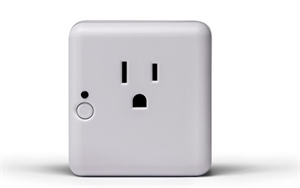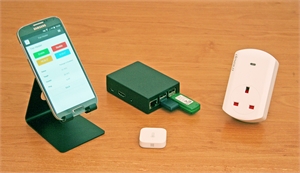Power
Smart plugs have been used extensively in the home for many years, and their repeater capability has been a key feature in the low power mesh networks. With the move away from single technology networks, dual band WiFi provides a better solution for mains powered devices. Although the future is in smart WiFi appliances, they are still some way off, so smart plugs and smart power relays will continue to be used well into the next decade.
Smart Plugs
Smart plugs are one of the three most commonly used devices, alongside motion sensors and door / window sensors.
As well as being able to control the power supply to almost any domestic appliance, smart plugs report their on / off status, and most report the energy being used. Some also report the local temperature, and provide an over-heating alert.
The only exception that we have encountered is the Everspring Wall Plug Lamp Dimmer. It provides a 0% to 100% dimming facility for table lamps, etc. It is limited to a maximum power of 400 Watts, and is intended only for use with a lamp, but, having a standard 13 Amp outlet, many users may overlook this limitation when using it.
Smart Plugs as Repeaters

Most smart have the ability to act as repeaters / range extenders, by relaying signals between other devices within a mesh network. They are a much better option than smart bulbs, many of which are known to have intrinsic faults, especially when connected to many similar devices.
In practice, there are known firmware issues in these devices that cause the bulb to randomly stop acting as a repeater. This applies to the bulbs from more than one manufacturer.
Being easily removed, especially when vacuum cleaning / hoovering, their ability to act as a repeater can be compromised, with the resulting loss of connection between the hub and other connected devices. Their location can also be easily changed, which may take them out of range of other connected devices, and again lose connection with them.
These are two of the many reasons why the signal strengths and signal quality of all of the devices should be monitored, and the user should be alerted to any significant reduction in either of these values. For the same reason, it is worth spending money or more on smart plugs, to ensure the robustness of the network, rather than suffering the consequences of operating with marginal radio signals.
Smart Power Relays
Power relays can also be fitted into the home wiring to control appliances directly, such as the Aeotec Z-Wave Micro Smart Energy Switch. These devices do not have a repeater capability, and are most suited to single fixed appliances.
As with the installed lighting devices, access has to be gained to the wiring between the mains supply and the appliance. In the UK, any electrical work of this type must be undertaken by a qualified electrician.
Smart Appliances
Smart appliances, such as WiFi kettles, can be controlled directly, rather than through a smart plug or a a smart power relay. These appliances are still rarely used in the UK, mainly due to their cost and the slow take-up of smart technology.
As increasing use will be made of smart appliances in the future, smart plugs and smart power relays might be viewed as an interim measure, but that interim period is likely to last well into the next decade.
ZigBee, Z-Wave, or WiFi
ZigBee and Z-Wave networks are best suited to battery powered devices, whereas WiFi networks are better suited to mains powered devices.
There is no requirement for low power battery operation with a mains powered device, and WiFi transmission speeds are very much higher than those of ZigBee and Z-Wave networks.
The 5 GHz option with dual band WiFi achieves even higher speeds, and in a less congested radio band.
Rather than being committed to a particular network, a mix of ZigBee, Z-Wave, and WiFi enables the best use to be made of the available technology.
The role of the smart plug operating as repeater in a ZigBee or Z-Wave network has to be taken into account. The choice is between an ZigBee or Z-Wave plug with the repeater capability and a higher performance, and possibly cheaper, WiFi plug without.
Room Heaters
Many people prefer to use a local room heater in the evening to save money, especially in the summer, or if the rest of the house is empty, instead of their central heating. Others cannot afford to run their central heating.

The temperature control of many room heaters is too course for normal use, so the room temperature is either too cold or too hot.
The solution is to have a temperature sensor in the room, and to allow it to control operation of the heater. The heater is powered through a smart plug, which is controlled by the system, based on the room temperature as measured by the temperature sensor.
The system operates by the user enabling an action on their app, which switches the heater on and off, based on the measured room temperature. The user can switch the heater off at any time by disabling this action, again via their app.
The user can also adjust the heating by increasing and decreasing the temperature, and by overriding the temperature sensor, so that the heater is switched permanently, also via their app. This enables the room temperature to be set to the most comfortable level, and the user to make adjustments, if needed, without leaving their seat.
The above photograph shows one of the tested multi-network configurations. A Z-Wave Devolo smart plug is used, together with a ZigBee Xiaomi temperature sensor. Two network adapters are used, a Z-Wave.me adapter for the Z-Wave network, and a Dresden Electronics ConBee adapter for the ZigBee network.
In practice, a Salus, Samsung, Hive, or other ZigBee smart plug can be used in place of the Devolo smart plug, so that a single ZigBee network is needed, instead of both a ZigBee network and a Z-Wave network.